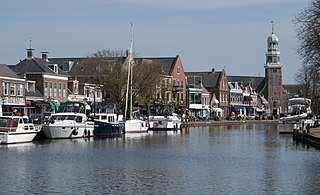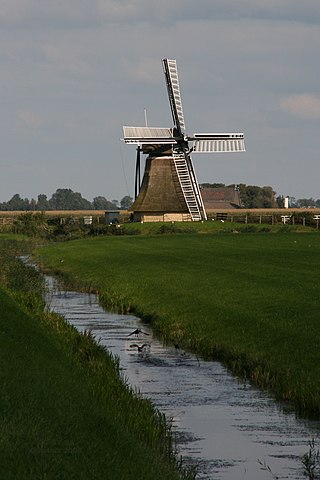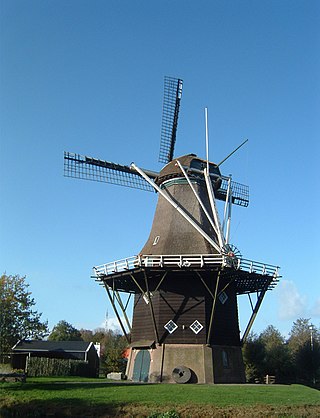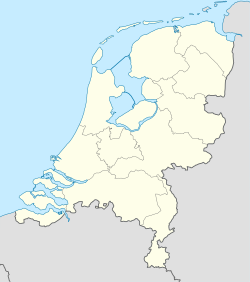
Leeuwarden is a city and municipality in Friesland, Netherlands, with a population of 127,073 (2023). It is the provincial capital and seat of the Provincial Council of Friesland.

Heerenveen is a town and municipality in the province of Friesland (Fryslân), in the Northern Netherlands. In 2021, the town had a population of 29,790 while the municipality had a population 50,859.

Skarsterlân is a former municipality in the province of Friesland in the Netherlands. The municipality was created 1 January 1984 by merging the municipalities of Doniawerstal and Haskerland, the part of Utingeradeel consisting of the villages Akmarijp and Terkaple and the village Nieuwebrug that used to belong to Heerenveen. City hall was located in Joure. On 1 January 2014 it merged with the municipalities of Lemsterland and Gaasterlân-Sleat to form the new municipality De Fryske Marren.

Lemmer is a town in the municipality of De Fryske Marren, in the Dutch province of Friesland. Lemmer lies adjacent to the IJsselmeer and the Frisian Lakes and is one of Friesland's best-known surface water sports locations. Lemmer is a bustling lakeside resort in the summer months and attracts not only day-trippers from surrounding communities such as Emmeloord, Urk, and Joure, but also national and international tourists.

Balk is a town in the northern Netherlands. It is a village of the municipality De Fryske Marren, province Friesland, and is located about 17 km southwest of Sneek.

Oudehaske is a village in De Fryske Marren in the province of Friesland, the Netherlands. It had a population of around 1980 in 2017.

Vegelinsoord is a village in De Fryske Marren municipality in the province of Friesland, the Netherlands. It had a population of around 390 in 2017.

De Achlumer Molen is a smock mill in Achlum, Friesland, Netherlands which has been restored to working order. The mill is listed as a Rijksmonument, number 15821.

De Broekmolen is a smock mill in Broeksterwâld, Friesland, Netherlands which has been restored to working order. The mill is listed as a Rijksmonument, number 11678.

Aylvapoldermolen is a smock mill in Burgwerd, Friesland, Netherlands which has been restored to working order. The mill is listed as a Rijksmonument, number 15626.

De Modderige Bol is a Hollow Post mill in Goëngahuizen, Friesland, Netherlands which has been restored to working order. The mill is listed as a Rijksmonument, number 34001.

Welgelegen or Tjepkema's Molen is a smock mill in Heerenveen, Friesland, Netherlands, which was built in 1849 and has been restored to working order. The mill is listed as a Rijksmonument, No. 21171.

The Hegebeintumer Mûne is a smock mill in Hegebeintum, Friesland, Netherlands which was built in 1860. The mill has been restored to working order. It is listed as a Rijksmonument, number 15629.

De Groene Molen is a hollow post mill in Joure, Friesland, Netherlands which was built c. 1800. The mill has been restored so that it can turn by wind. It is listed as a Rijksmonument, number 18208.

Penninga's Molen or De Jonge Wester is a smock mill in Joure, Friesland, Netherlands which was built in 1900 and is working for trade. It is also used as a training mill. The mill is listed as a Rijksmonument, number 20842.

De Vlijt or Molen 't Op is a post mill in Koudum, Friesland, Netherlands which was built in 1986 and is working in working order. The mill is listed as a Rijksmonument, number 34081.

De Fryske Marren is a municipality of Friesland in the northern Netherlands. It was established 1 January 2014 and consists of the former municipalities of Gaasterlân-Sleat, Lemsterland, Skarsterlân and parts of Boarnsterhim, all four of which were dissolved on the same day. The municipality is located in the province of Friesland, in the north of the Netherlands, and has a population of 51,778 and a combined area of 559.93 km2 (216.19 sq mi).

Fedde Schurer was a Dutch schoolteacher, journalist, language activist and politician, and one of the most influential poets in the West Frisian language of the 20th century.
Abe de Vries is a Frisian poet, essayist, literary critic, journalist, editor, translator and photographer.




























